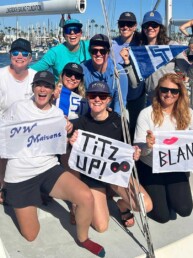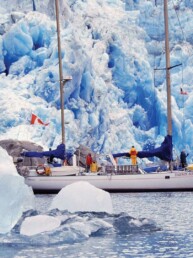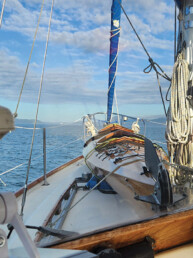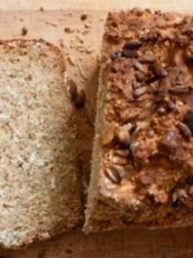A Second Cruise Brings Border Crossings, Uncertainty, and Lessons Learned.

It’s an image I’ll never forget: my wife, Kate, hoisting our boathook overhead, a radar reflector lashed to the tip, as we were engulfed in fog on the edge of Haro Strait. A moment ago, we could see Vancouver Island clearly five miles distant; now only the forestay was visible on the bow of Luna, our 19-foot wooden catboat. Beyond us, somewhere in the shipping lanes, a tanker honked relentlessly.
“What are we going to do now?” Kate asked, her voice strained with fear. “That ship is going to clobber us.”
“Moresby Island is much closer than you think,” I said, holding up the GPS. “Plus, I’ve got a compass bearing and we’re way out of the lanes. We’re safe.”
“If you say so,” she replied, staring into the all-encompassing whiteness.
It was one more tense moment in the see-saw of emotions experienced during our second cruise together. After years of solo small boat adventuring, Kate joined me for the first time the previous summer and we spent two weeks roaming the San Juans (see “Close to the Water” in last month’s issue of 48° North). It went so well that we set aside three weeks this summer to go farther, but if last year was a dream cruise, this year’s voyage had a touch of nightmare.
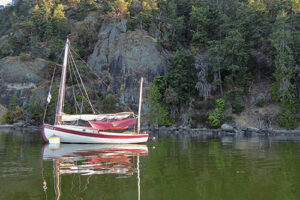
A week earlier, we’d packed Luna and launched in Anacortes, more comfortable with the boat than last summer, as well as the basics of cruising together. We departed under calm, sunny skies, but despite the slack tide, out in Rosario Strait I felt like a mouse being toyed with by a cat. Wavelets and chop bashed into Luna as we bumped our way across. Luna’s high bow deflected spray, and the cockpit remained dry, but Kate’s silence and furrowed brow told me all I needed to know: Hurry up, and get me out of this boat.
Reaching Spencer Spit State Park, I handily nosed Luna up to a mooring ball where, using lessons learned last year, Kate deftly hooked its ring with our boat hook and secured a line. We both cheered and collapsed into the cockpit for appetizer hour. After dinner, we loaded into a dinghy I’d built over the winter. I beamed with pride as it tracked perfectly and easily accommodated both of us in comfort.
Come morning, the pendulum hand swung the other way. “Honey, did you by chance spill some water on me?” I asked, baffled by the damp seeping into my sleeping bag.
A peek beneath the floorboards soon revealed that the garboard plank was weeping. And after two days at sea, enough water had gathered to slosh out of the bilge and onto my bedding. This necessitated an unplanned trip to Friday Harbor to acquire some epoxy putty to staunch the flow.
From there it was a noisy motorized hop to Jones Island, our favorite state park. Although the wind had been on our nose so far, luck now turned in our favor. Not only did we get the last spot at the dock, but we soon met a sailor who was also a fisherman. “I’ll catch you some flounder,” Paul offered, and a few hours later Kate and I were sitting at a picnic table, drinking wine and preparing two fresh fish. I never would have guessed that just olive oil, salt, pepper, and heat could create such perfection. We gazed at the charming cove, filled with cruisers, and at the island peaks in the distance. For all this, a little water on my sleeping bag seemed a small price to pay.
Time passed surprisingly quickly, and soon we had spent our allotted three days at the dock, and it was time to move on. The Salt Spring Island Cheese Company had put a spell on Kate several years earlier, and the call to return was strong. But getting there required crossing Haro Strait, where we encountered that fog. Fortunately, it didn’t last long and the container ship passed by us uneventfully.
We arrived at the Canadian customs dock in Bedwell Harbour with just a few big trawlers ahead of us. The customs folks clearly dismissed our tiny wooden boat as any kind of smuggling threat, since they didn’t bother searching it for contraband while the agents crawled all over the bigger craft like ants at a picnic. Our real challenge for the day was deciding which of the 10 mooring buoys at the adjacent provincial park to choose.
Before long, cheese was procured and devoured. We enjoyed puzzling over the relative spending power of Canadian dollars. There were relaxed walks in the woods and strolls through quaint towns. We even avoided what would have been a hard, rainy slog to another island by taking a ferry instead. A few days later, on the edge of Haro once again, our bow turned eastward, the thick fog returned, for just long enough to silence Kate with fear (though it dissipated before we needed to deploy the radar reflector).

A different challenge came when we approached the United States border near Roche Harbor. The Customs Border Patrol Roam App failed to work properly and an annoyed agent called my cell phone.
“You didn’t fill out the declaration tab properly,” he said tersely. “And you scanned the wrong documents. Report to Friday Harbor immediately.”
It would take our tubby little boat at least two hours of annoying motoring against another headwind to make it there. Crestfallen, I saw the quiet anchorage and delicious meal I’d been coveting at the nearby Westcott Bay Shellfish Company slip away.
Clearing customs at Friday Harbor barely took five minutes. Grouchy and too demoralized to head all the way back to Westcott, we chugged over to a cove on the edge of town and anchored.
Then, while assembling the cockpit tent, one of its support poles slipped out of our hands. Like a spectator at a movie, I watched it glide over the coaming and sink silently into the water.
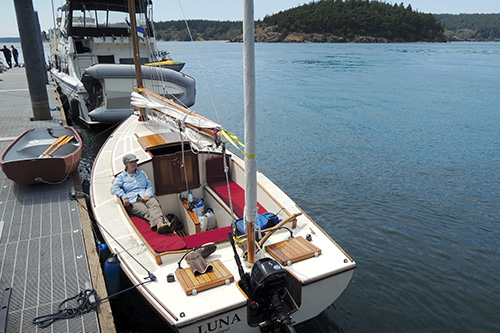
“What’s the tide doing,” Kate asked, equally shocked. “Maybe we can retrieve it later?”
With oozy mud and a vast field of trash can lid-sized sea lettuce below I just shook my head. There were two remaining poles, and we’d have to make it work.
Despite these setbacks, we regrouped the next morning, rowed ashore, and climbed aboard the local bus, which took us to historic English Camp, where a hiking trail through the woods led us directly to Westcott and the oysters we’d been craving. It wasn’t the way we’d planned to get there, but as we sat at our patio table, looking out at the sparkling bay, I grinned. As is often the case on a cruise, we adapted and found something special in the process.
The unexpected day on San Juan Island had turned out well, but we were ready to go home. Since we couldn’t make it back to Anacortes in one day, we set our sights on James Island hoping that, unlike last year, there would be room for us at the dock.
Current swirled as we approached the park’s tiny cove. I gunned the motor, making a wide arc, so our bow faced away from the island, while Kate deployed the fenders and wielded the boat hook. Together we executed a perfect parallel parking job on the tiny dock. A bevy of small boats soon piled up nearby, including a family with a baby and a sailing father and adult daughter, making a lively scene. Arriving here felt like a more rugged version of our beloved Jones Island. Hiking over the steep hills, chatting up birdwatchers, and admiring the rippling waters surrounding us buoyed our mood.
Come bedtime, a wind blew against the ebb tide pushing past the dock, creating an unbearable bucking, rocking motion in our cabin. In the dark, we hauled a tarp and our sleeping gear up to the campground’s picnic shelter. The moon was rising, casting a silver glow on the water and highlighting the bold silhouettes of the fir trees surrounding us. Despite our unanticipated new sleeping quarters we smiled, snugged up in our sleeping bags, relieved by the solid, comforting stillness of the land.
Months later, looking back over our ship’s log, I read a tale of challenging and unusually strong conditions for summer that often dampened Kate’s enthusiasm. When solo, things that test my skills and judgment often make a trip memorable and interesting. However, continuously playing the roles of captain, safety officer, and navigator with Kate aboard forced me to take on a different burden of responsibility, and Kate to depend on me, to a degree that was new and unsettling to both of us.

I was edging towards selling Luna when we got back. Rightly or wrongly, the boat seemed to embody the shortcomings of our cruise. I didn’t want to revisit them, yet I couldn’t help dwelling on them. Unloading the boat would solve that problem I thought.
Yet as the fall progressed and Kate and I both gained some distance, we found ourselves looking back on our mishaps with less angst, coming to see them not as the disappointments we felt so keenly at the time. Now, instead of lingering in the dark times, it was the moments of great beauty that we recalled. Gradually we found ourselves wondering how we might do things differently on a future trip.
We’ve got the winter to figure it out.
Bruce Bateau sails and rows traditional boats with a modern twist in Portland, Oregon. His stories and adventures can be found at www.terrapintales.wordpress.com.
Bruce Bateau
Bruce Bateau sails and rows traditional boats with a modern twist in Portland, Ore. His stories and adventures can be found at www.terrapintales.wordpress.com

